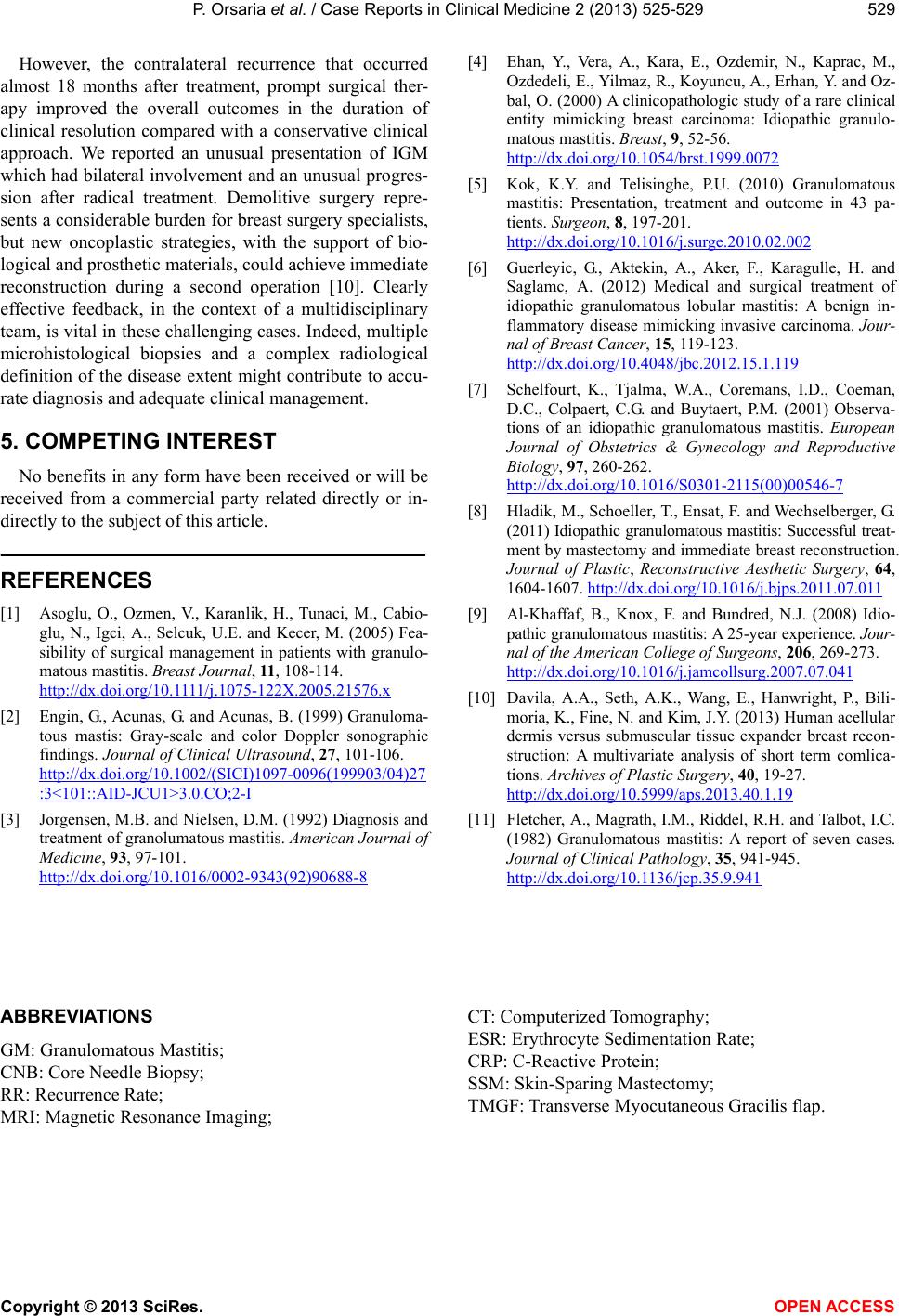
P. Orsaria et al. / Case Reports in Clinical Medicine 2 (2013) 525-529
Copyright © 2013 SciRes.
529
[4] Ehan, Y., Vera, A., Kara, E., Ozdemir, N., Kaprac, M.,
Ozdedeli, E., Yilmaz, R., Koyuncu, A., Erhan, Y. and Oz-
bal, O. (2000) A clinicopathologic study of a rare clinical
entity mimicking breast carcinoma: Idiopathic granulo-
matous mastitis. Breast, 9, 52-56.
http://dx.doi.org/10.1054/brst.1999.0072
However, the contralateral recurrence that occurred
almost 18 months after treatment, prompt surgical ther-
apy improved the overall outcomes in the duration of
clinical resolution compared with a conservative clinical
approach. We reported an unusual presentation of IGM
which had bilateral in volvement and an unusual progres-
sion after radical treatment. Demolitive surgery repre-
sents a co nsid erab le burden fo r breas t surgery specia lists,
but new oncoplastic strategies, with the support of bio-
logical and prosthetic materials, could achieve immediate
reconstruction during a second operation [10]. Clearly
effective feedback, in the context of a multidisciplinary
team, is vital in these challenging cases. Indeed, multiple
microhistological biopsies and a complex radiological
definition of the disease extent might contribute to accu-
rate diagnosis and adequate clinical management.
[5] Kok, K.Y. and Telisinghe, P.U. (2010) Granulomatous
mastitis: Presentation, treatment and outcome in 43 pa-
tients. Surgeon, 8, 197-201.
http://dx.doi.org/10.1016/j.surge.2010.02.002
[6] Guerleyic, G., Aktekin, A., Aker, F., Karagulle, H. and
Saglamc, A. (2012) Medical and surgical treatment of
idiopathic granulomatous lobular mastitis: A benign in-
flammatory disease mimicking invasive carcinoma. Jour-
nal of Breast Cancer, 15, 119-123.
http://dx.doi.org/10.4048/jbc.2012.15.1.119
[7] Schelfourt, K., Tjalma, W.A., Coremans, I.D., Coeman,
D.C., Colpaert, C.G. and Buytaert, P.M. (2001) Observa-
tions of an idiopathic granulomatous mastitis. European
Journal of Obstetrics & Gynecology and Reproductive
Biology, 97, 260-262.
http://dx.doi.org/10.1016/S0301-2115(00)00546-7
5. COMPETING INTEREST
No benefits in any form have been received or will be
received from a commercial party related directly or in-
directly to the subject of this article. [8] Hladik, M., Schoeller, T., Ensat, F. and Wechselberger, G.
(2011) Idiopathic granulomatous mastitis: Successful treat-
ment by ma stectomy an d immediate breast reconst ruction.
Journal of Plastic, Reconstructive Aesthetic Surgery, 64,
1604-1607. http://dx.doi.org/10.1016/j.bjps.2011.07.011
REFERENCES
[1] Asoglu, O., Ozmen, V., Karanlik, H., Tunaci, M., Cabio-
glu, N., Igci, A., Selcuk, U.E. and Kecer, M. (2005) Fea-
sibility of surgical management in patients with granulo-
matous mastitis. Breast Journal, 11, 108-114.
h ttp://dx.doi .or g/10.1111/j.1075-122X.2005.21576.x
[9] Al-Khaffaf, B., Knox, F. and Bundred, N.J. (2008) Idio-
pathic granulomatous mastitis: A 25-year experience. Jour -
nal of the American College of Surgeons, 206, 269-273.
http://dx.doi.org/10.1016/j.jamcollsurg.2007.07.041
[10] Davila, A.A., Seth, A.K., Wang, E., Hanwright, P., Bili-
moria, K., Fine, N. and Kim, J.Y. (2013) Human acellular
dermis versus submuscular tissue expander breast recon-
struction: A multivariate analysis of short term comlica-
tions. Archives of Plastic Surgery, 40, 19-27.
http://dx.doi.org/10.5999/aps.2013.40.1.19
[2] Engin, G., Acunas, G. and Acunas, B. (1999) Granuloma-
tous mastis: Gray-scale and color Doppler sonographic
findings. Journal of Clinical Ultrasound, 27, 101-106.
http://dx.doi.org/10.1002/(SICI)1097-0096(199903/04)27
:3<101::AID-JCU1>3.0.CO;2-I
[3] Jorgensen, M.B. and Nielsen, D.M. (1992) Diagnosis and
treatment of granolumatous mastitis. American Journal of
Medicine, 93, 97-101.
http://dx.doi.org/10.1016/0002-9343(92)90688-8
[11] Fletcher, A., Magrath, I.M., Riddel, R.H. and Talbot, I.C.
(1982) Granulomatous mastitis: A report of seven cases.
Journal of Clinical Pathology, 35, 941-945.
http://dx.doi.org/10.1136/jcp.35.9.941
ABBREVIATIONS CT: Computerized Tomography;
ESR: Erythrocyte Sedimentation Rate;
GM: Granulomatous Mastitis; CRP: C-Reactive Protein;
CNB: Core Needle Biopsy; SSM: Skin-Sparing Mastectomy;
RR: Recurrence Rate; TMGF: Transverse Myocutaneous Gracilis flap.
MRI: Magnetic Resonance Imaging;
OPEN ACC ESS